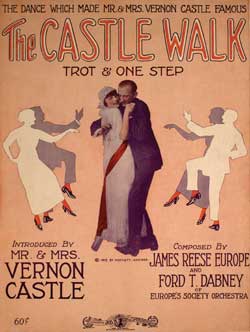

The syncopated element of ragtime began to be used in social dancing, particularly in dances such as the One Step (a fast march with syncopated rhythm). The One Step was a ballroom dance that became popular around 1910, largely due to the efforts of Vernon and Irene Castle, a husband and wife team who were renowned in Europe and the United States for their social dancing (they owned a dance studio called The Castle House). One of the variations of the One Step was called the Castle Walk, and it was invented by the Castles [143] (the Castles are featured on the front cover of the sheet music in figure 6.16).
The Castle Walk was composed in 1913 by James Reese Europe (1880-1919), and Ford Thompson Dabney (1883–1958). Europe was a bandleader and composer, and made significant contributions towards the emergence of jazz. At one point in his career, Europe was the musical director for Vernon and Irene Castle. This partnership apparently had a dramatic impact on social dance in America, and the scholar Reid Badger noted: "the Castle-Europe partnership revolutionized American attitudes towards social dancing." [144] Europe frequently collaborated with Dabney, a songwriter and bandleader (Dabney also played piano in Europe's dance orchestras). Europe and Dabney composed the piece The Castle Walk for the Castles, and the Castles used it to introduce their dance variation of the One Step, the Castle Walk. Europe also has the distinction of being one of the first black bandleaders to record with a major record label in the United States. Europe and his Society Orchestra received a recording contract from Victor Records in 1913, and one of the pieces recorded at Europe's 1914 second session at Victor Records, was The Castle Walk. [145] [146]
TECHNIQUE TIPS: The Castle Walk has the rhythmic, syncopated feel of ragtime music. The tempo marking at the beginning of this arrangement is con spirito, meaning, play with spirit in a lively, animated manner. In measures 45-47, there is a spiccato section. Spiccato is an off-the-string, controlled bouncing bow stroke which produces a crisp sound and very short notes. To perform this bow stroke, try to find a spot on your bow where you're able to produce a controlled, light bounce (try starting in the middle).
© Copyright 2025 RK Deverich. All rights reserved.
Although this online bass class is provided free of charge, all rights are reserved and this content is protected by international copyright law. It is illegal to copy, post or publish this content in any form, and displaying any of this material on other websites, blogs or feeds is prohibited. Permission is given for individual users to print pages and perform music from this website for their personal, noncommercial use.